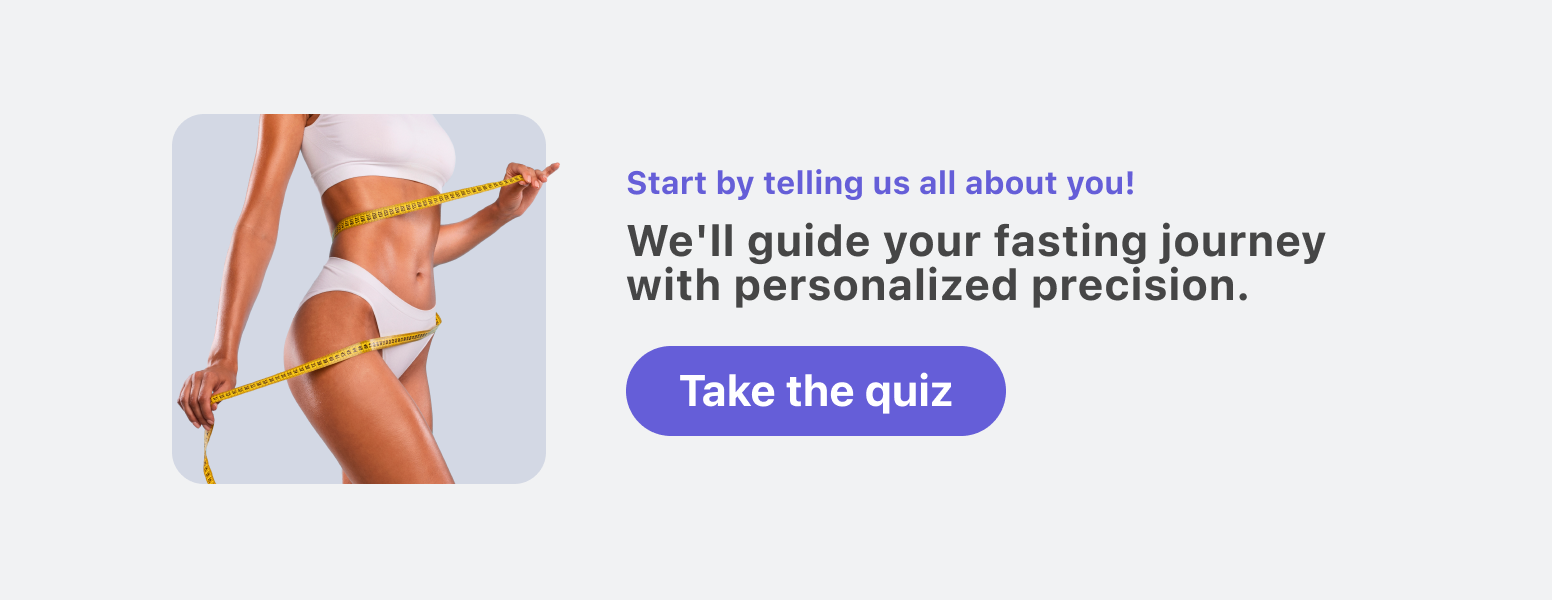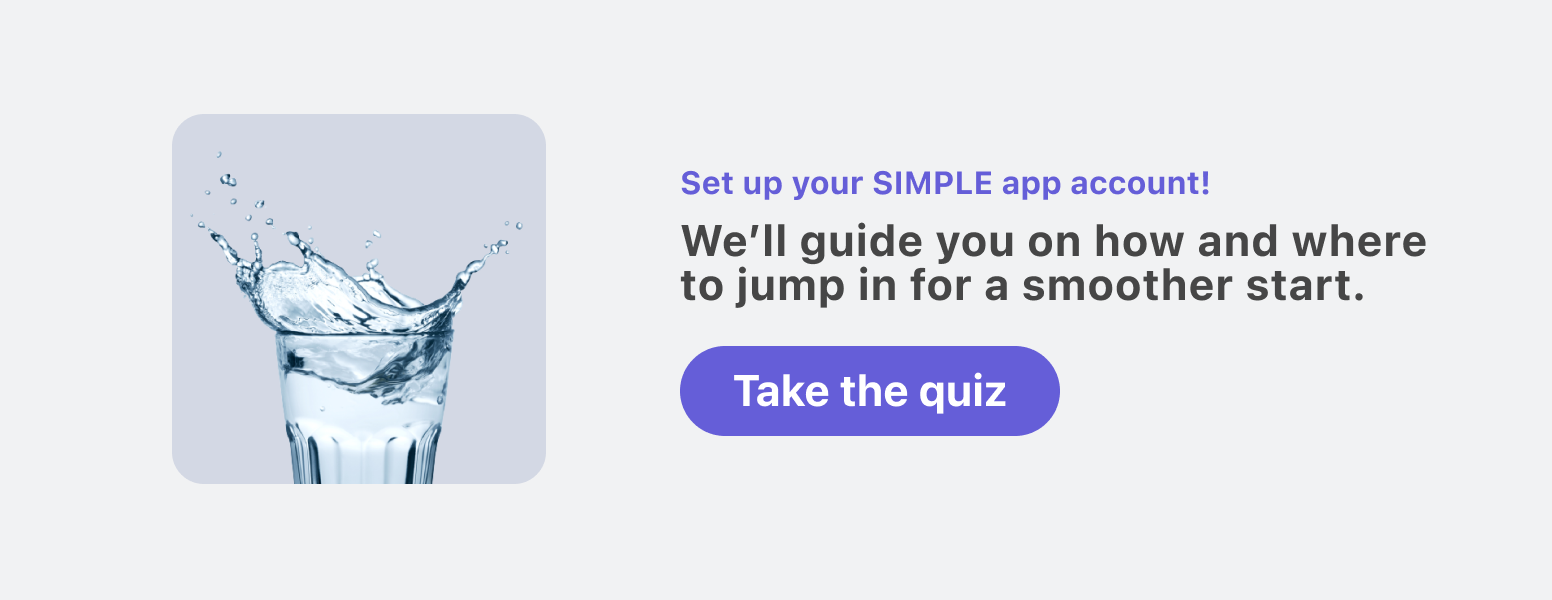Intermittent fasting 14:10 vs. 16:8: which is better for you?

You’ve been dabbling in the intermittent fasting info pool, thinking about getting started on this lifestyle that’s been claimed to be an easier and more flexible way to gain control of your health and maybe lose some weight.

There are many types of intermittent fasting methods to choose from, but we’re going to compare two of our favorites around here at Simple: intermittent fasting 14:10 vs. 16:8. Both are forms of time-restricted eating (TRE), a method of controlling how much you eat by how long you eat.
We like 14:10 intermittent fasting because it’s one of the easier schedules to step into due to the shorter fasting period. With a slight extension of your natural fasting period, you can still see some decent benefits and results for your body.[1]
We like 16:8 intermittent fasting because it is a long enough fasting window to see optimized results but not so long that it’ll have you questioning your life decisions and how you got here.
Let’s dive a little deeper into the question, “Is 14:10 fasting as good as 16:8?” so you’re fully equipped to decide which one will work for you and your body or if you’re better suited to another schedule altogether.
14:10 intermittent fasting — what is it?
On a 14:10 schedule, you fast for 14 hours and eat during a 10-hour window.
14 hours sounds like a long time to go without eating. But, if you think about the fact that you’re fasting while you sleep, it’s not that much longer than the nightly fast you’re already doing.
It’s a great place to start with intermittent fasting for beginners. And you may decide to stick with it for the long haul if it proves to work just fine for your body and your goals.
Benefits
Fat loss
One benefit of intermittent fasting is its ability to focus weight loss on fat loss. So long as you plan ahead to ensure you eat enough protein during your eating window, intermittent fasting could help you lose fat while maintaining muscle.[2] Fat loss over weight loss is the more sustainable way to change your body composition.
It has also been shown to be better at helping you lose visceral fat (the kind that likes to surround your vital organs) than other calorie-restricted diets.[3]
Lower blood pressure
High blood pressure can be a dangerous condition. It’s also known as “the silent killer” because it can go unnoticed until it’s already done serious damage. Intermittent fasting can help improve blood pressure especially due to its effect it has on weight loss.[4] If weight loss is not your goal, it is possible to see results with no change in weight. If you’re already diagnosed with high blood pressure and are taking medication for it, it’s a good idea to work with your doctor to put a plan together before starting intermittent fasting.
Reduced cholesterol
High cholesterol levels can lead to heart disease, but with 14:10, you could see improvement in markers like total cholesterol and LDL.[5]
Improved blood sugar
If blood sugar is a concern for you, you’ll be happy to know that decreased insulin response, increased insulin sensitivity, and overall better blood sugar control all fall under the benefits of fasting.[6,7]
Lower risk of metabolic syndrome
These four health benefits (fat loss, lower blood pressure, reduced cholesterol, and improved blood sugar) together add up to a lower risk of metabolic syndrome, but more research is required before we can determine anything definitively.[8]

Drawbacks
You may not reach ketosis
When fasting, your body has to switch from using glucose and stored glycogen for energy,\ to using fat. This is a state known as ketosis. While some people can achieve ketosis in as little as 12 hours, for others, 14 hours isn’t long enough, or it may not allow your body to spend enough time in ketosis to see results as quickly as you want.
It can be hard at the start
At the start of your fasting lifestyle, you’ll likely experience intermittent fasting side effects like hunger and irritability, low energy levels, and dehydration.
These symptoms should be short-lived as your body adjusts. You can also help avoid some of them if you plan ahead to stay hydrated and eat a variety of health-promoting foods. Doing this will also help you optimize the results of your shorter fasting window. Your body will thank you!
16:8 intermittent fasting — what is it?

The 16:8 schedule is eating during an 8-hour window and fasting during the remaining 16 hours. We know that can sound a little scary! 16:8 can be a little more difficult to tackle vs. 14:10 fasting, but it’s still very doable.
16:8 is often favored because it’s short enough to be safe yet long enough to see some real changes in your body. These results are many of the same benefits we’ve just seen for 14:10 but taken up a gear courtesy of a 14-hour fast vs. a 16-hour fast.
Benefits
Improved brain health
While a 14:10 schedule can potentially deliver this benefit, you are more likely to see it with 16:8. That’s because the longer fast is more likely to induce autophagy. While a lot of the research on autophagy is new, it is thought to help improve brain health and prevent degenerative diseases like dementia.[9]
Reduced late-night snacking
Because of the longer fasting window, with 16:8, you’ll need to plan to stop eating earlier in the day. If the late-night munchies are where you tend to collect some extra calories, this fasting method can help you kick that habit.
Drawbacks
It can be harder to implement
A longer fasting window can be harder to fit into your lifestyle. If family dinners are important to you, your schedules make late breakfast impossible, or you love hanging out in the evening with friends at the local pub, 16:8 could be hard to maintain without some creative scheduling on your part.
Increased risk of symptoms
Just as 16:8 can intensify the benefits, it can intensify the symptoms and risks, too. Those tough early days may be a little harder and include dizziness, headaches, and brain fog. Plan for your body to need a little more time to adjust.
You may also be more susceptible to intermittent fasting mistakes that can make your fasting journey a bit rocky. Take our Simple quiz, set up your Simple app account, and we’ll guide you on how and where to jump in for a smoother start. We’ve got reminders, trackers, and expertly crafted resources to help you find your fasting sweet spot. We SIMPLY can’t deny our methods are the best!

14:10 vs. 16:8 intermittent fasting
Now that you’ve learned a little about each of these heavy-hitter schedules, let’s put them in the ring and compare 14:10 vs. 16:8 fasting under these three pillars: length of fast, flexibility, and health benefits.
Fasting period
The major difference between 14:10 and 16:8 is the length of both the fasting and eating windows.
With less time to eat on 16:8, you’ll most likely have a lower calorie intake, and if you’re here for weight loss, that’s a win! But it might also be harder to get in all the nutrients you need, especially without a good plan — a point for 14:10.
Let’s call this round a tie.
Flexibility
Flexibility is one of the key benefits of all fasting schedules. Each one can be adapted to suit different lifestyles and preferences.
But, when it comes to 14:10 vs. 16:8, it’s easier to plan the social parts of your regular eating pattern around 10 hours than it is eight, so we’re gonna call 14:10 the champion of this round.
The sustainability and benefit of any wellness change have more to do with how feasibly and comfortably it fits into your life than the results it offers. So, if the 16:8 method isn’t a good fit for you and causes you more stress than it solves, let 14:10 be your winner.
Health benefits
The health benefits we see from 14- vs. 16-hour fasts will vary from person to person.
That said, with 16-hour fasting, it’s more likely you’ll hit that metabolic switch where you really begin to see all that fasting can achieve,[10] like lower blood sugar, lower blood pressure, improved cholesterol, and lower risk of heart disease. But, again, if 16 hours is too much for you and causes more stress (mental or physical), it reduces the benefit.
Ultimately, the method that works best for you and your lifestyle is the champion, so we’re going to have to call this a tie as well.
We seem to have hit a stalemate, but that’s OK. There are no winners and losers when it comes to a 16:8 vs. a 14:10 fasting schedule showdown. The real MVP is YOU when you take our Simple quiz and get a plan in place to get your intermittent fasting journey underway. You can start to discover which one (or which combination — yes, you can do that too: 14:10 some days, 16:8 on others, however they best fit!) works best for you.
Tips on choosing the right intermittent fasting schedule for you

Know your why
Fasting is yours to shape as you need — the only “rules” are when you start and stop eating (and you get to choose that as well). Use your why to guide you. Are you fasting to cut calories? To help you eat more mindfully? To support your overall health and lower your risk of disease? To lose some weight? Maybe you just want to feel better in your body. Get clear on your goal before you get started. Knowing your why will also help you stay motivated when things get tough.
Check in with your doctor
There are select groups of people that we recommend avoid intermittent fasting methods altogether unless they have their doctor’s express permission and support. This includes anyone who:
- is pregnant, breastfeeding, or trying to conceive
- has type 1 diabetes
- is on prescription medications
- is under 18 years old, or 80 years old or more
- is extremely active
- has a body mass index (BMI) < 18.5
- has an eating disorder or a history of one (or is at risk of developing one)
If you’re going to try it, make sure your doctor is aware and check in with them regularly. Together, make a plan for if things go south. We recommend everyone check in with their doctor before starting a new nutrition strategy, so this is good advice even if you don’t fall into one of the groups listed above.
Start slow
Take a look at how long you currently fast (i.e., between your last meal of today and your first meal of tomorrow). Perhaps adding 1–2 hours to that would be the best method for you to begin.
Alternatively, you could start with 12:12 or 14:10 — these are both great schedules for beginners.
The slow and steady method can give you a chance to pay attention to how your body feels and adjust as needed. You can lengthen your fasts based on how you feel or stick to what you’re doing if it’s working well!
Frequently asked questions about 14:10 vs. 16:8
Yes, in general, 14:10 is enough for intermittent fasting. You can see benefits with as little as a 12-hour fast.[5] Whether or not 14:10 is enough for your body depends on what you want to achieve. Ketosis is less likely, so if ketosis and weight loss are your goals, perhaps start with 14:10, then push for a little longer.

- Wilkinson MJ, Manoogian ENC, Zadourian A, Lo H, Fakhouri S, Shoghi A, et al. Ten-Hour Time-Restricted Eating Reduces Weight, Blood Pressure, and Atherogenic Lipids in Patients with Metabolic Syndrome. Cell Metab. 2020 Jan 7;31(1):92–104.e5.
- Welton S, Minty R, O’Driscoll T, Willms H, Poirier D, Madden S, et al. Intermittent fasting and weight loss: Systematic review. Can Fam Physician. 2020 Feb;66(2):117–25.
- Kesztyüs D, Cermak P, Gulich M, Kesztyüs T. Adherence to Time-Restricted Feeding and Impact on Abdominal Obesity in Primary Care Patients: Results of a Pilot Study in a Pre-Post Design. Nutrients [Internet]. 2019 Nov 21;11(12).
- Wang W, Wei R, Pan Q, Guo L. Beneficial effect of time-restricted eating on blood pressure: a systematic meta-analysis and meta-regression analysis. Nutr Metab . 2022 Nov 8;19(1):77.
- Gabel K, Cienfuegos S, Kalam F, Ezpeleta M, Varady KA. Time-Restricted Eating to Improve Cardiovascular Health. Curr Atheroscler Rep. 2021 Mar 26;23(5):22.
- Yuan X, Wang J, Yang S, Gao M, Cao L, Li X, et al. Effect of Intermittent Fasting Diet on Glucose and Lipid Metabolism and Insulin Resistance in Patients with Impaired Glucose and Lipid Metabolism: A Systematic Review and Meta-Analysis. Int J Endocrinol. 2022 Mar 24;2022:6999907.
- Che T, Yan C, Tian D, Zhang X, Liu X, Wu Z. Time-restricted feeding improves blood glucose and insulin sensitivity in overweight patients with type 2 diabetes: a randomised controlled trial. Nutr Metab . 2021 Oct 7;18(1):88.
- Regmi P, Heilbronn LK. Time-Restricted Eating: Benefits, Mechanisms, and Challenges in Translation. iScience. 2020 Jun 26;23(6):101161.
- Gudden J, Arias Vasquez A, Bloemendaal M. The Effects of Intermittent Fasting on Brain and Cognitive Function. Nutrients [Internet]. 2021 Sep 10;13(9).
- Anton SD, Moehl K, Donahoo WT, Marosi K, Lee SA, Mainous AG 3rd, et al. Flipping the Metabolic Switch: Understanding and Applying the Health Benefits of Fasting. Obesity . 2018 Feb;26(2):254–68.
